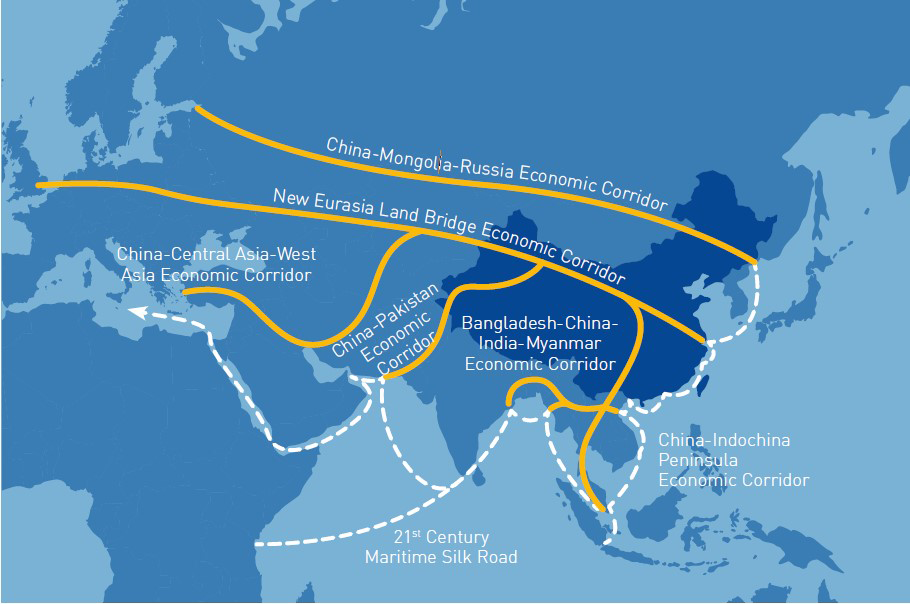 The size and scope of China’s Belt & Road Initiative (BRI) warrant European companies, including SMEs, giving it a close look. In fact, according to the European Chamber’s Business Confidence Survey 2018, businesses are doing just that: more than half of respondents saw opportunities in the BRI.[1] However, challenges and risks lie in wait for European business in this initiative, and they are magnified in the case of SMEs. This article from the EU SME Centre in Beijing introduces the primary sectors that hold business potential for the European business community, and signals what to look out for when cooperating in BRI projects. The article also highlights a success story of a European SME benefitting from BRI.
The size and scope of China’s Belt & Road Initiative (BRI) warrant European companies, including SMEs, giving it a close look. In fact, according to the European Chamber’s Business Confidence Survey 2018, businesses are doing just that: more than half of respondents saw opportunities in the BRI.[1] However, challenges and risks lie in wait for European business in this initiative, and they are magnified in the case of SMEs. This article from the EU SME Centre in Beijing introduces the primary sectors that hold business potential for the European business community, and signals what to look out for when cooperating in BRI projects. The article also highlights a success story of a European SME benefitting from BRI.
Six Economic Corridors Identified in BRI
The BRI is made up of six terrestrial ‘Economic Corridors’ that lead from China through South and Southeast Asia, the Middle East and across Eurasia to Europe. These Economic Corridors are mainly identifiable by the developing large-scale transport infrastructure that seek to form physical connections between the regions and sub-regions covered by the BRI. Additionally, the BRI’s maritime component, the 21st Century Maritime Silk Road (MSR), connects and overlaps with the three southern economic corridors before moving on to East Africa and the Mediterranean Sea, while also seeking to expand and connect projects and trade routes across the Middle East.

Souce: Belt and Road Initiative – Southern Routes, UK-China Cooperation and Opportunities, China-Britain Buiness Council, 2018.
Key BRI Sectors
In the six terrestrial economic corridors (the ‘Belt’ of the BRI) the Chinese Government has prioritised projects in nine key sectors. Each holds potential for a range of SMEs:
- Infrastructure: The focus areas of infrastructure investment in the BRI are railways, oil and gas pipelines, and electricity transmission/distribution networks. SMEs should explore opportunities in supply chain manufacturing facilities in third countries; water and waste management projects; regional trade and logistics centres; and urbanisation projects.
- Financial and Professional Services: EU SMEs are well-positioned to utilise their experience and expertise in assisting Chinese companies in international trade.
- Agriculture and Environment: to improve China’s food security, investments in environmentally-sustainable agricultural infrastructure are planned along the Belt.
- Manufacturing and Transport: the construction of high-speed railways, ports, airports, hydro-power plants and high-tech industrial parks will require high-end equipment, much of which China will seek from suppliers abroad.
- Energy and Resources: More than half of infrastructure spending along the BRI will end up in electricity production industries.
- E-commerce and Logistics: New platforms for B2B and B2C transactions may be especially useful to SMEs lacking the resources available to multinationals. Efficient and well-managed logistics centres will also be needed.
- Healthcare and Life Sciences: In 2017 China announced the formation of an international biomedical alliance to promote cooperation in biomedicine and healthcare sectors between BRI countries.
- Tourism: Western provinces, such as Gansu or Jiangsu, are looking to increase their attractiveness to tourists.
- Creative and Culture: The Chinese Ministry of Culture has published a ‘Belt and Road Cultural Development Action Plan’; so far, 300 agreements on exchanges with other nations have been signed.
Main risks to look out for
Risks to European SMEs range from a lack of transparency regarding vital information to the daunting complexity of partnerships that companies might find themselves entangled in. More specifically, SMEs should make themselves aware of the following types of risks:
- Operational risks and poor execution: BRI projects can be transnational and complex. Lack of experience in delivering and managing such projects can lead to delays and cost overruns.
- Partnership risks: It can be challenging to establish a high-level of trust and commitment with local partners who may be new to working with foreign companies and investors.
- Geopolitical risks: Changes in po¬litical regimes or in bilateral relations between countries involved in the BRI during a project’s lifespan can expose SMEs to potentially ruinous blowbacks.
- Investment exposure: According to the CSIS, “elections, corruption, com¬plicated land rights and other political and legal risks can threaten a project’s viability.… These risks are why institu¬tional investors, such as pension funds and insurance companies, rarely ven¬ture into infrastructure outside OECD economies.”[2]
- Funding risks: Exacerbated by higher capital and debt service ratios of BRI projects, host countries might encoun¬ter difficulties in repaying loans.
- Non-transparency in tenders/ non-level playing field: The CSIS reports that out of all the contrac¬tors participating in Chinese-funded transportation projects 89 per cent are Chinese companies, with only 7.6 per cent local and 3.4 per cent foreign. In World Bank and Asian Development Bank-funded projects, 29 per cent of the contractors are Chinese, 40.8 per cent are local, and 30.2 per cent are foreign.[3]
How European SMEs can get Involved
At the policy level at least, the Chinese Government has been making room for the participation of SMEs in the BRI. For in-stance, China’s Ministry of Information and Technology (MIIT) and the China Council for the Promotion of International Trade (CCPIT) published a notice in July 2017 to promote further involvement of SMEs in the BRI. Noteworthy measures include:
- innovating with the China International SME Expo;
- establishing the “BRI Cooperation Plat¬form for SMEs”, a platform to provide SMEs with information and services;
- attracting R&D institutions from BRI-in¬volved countries to set up in China;
- promoting two-way investment in SMEs and supporting the construction of a cooperative zone for SMEs in China and other countries; and
- deepening bilateral and multi-lateral consultation and cooperation mech¬anisms with SMEs in fields under the jurisdiction of the MIIT.
In addition, European SMEs can contribute their experiences and know-how to BRI projects, benefitting from cooperation:
- As investors – partnering with Chinese companies or in existing BRI financial instruments, especially as China looks for alternative financing for the BRI.
- As suppliers – providing advanced products that comply with high envi¬ronmental and safety standards.
- As partners – contributing technolog¬ical and technical know-how in collabo¬ration with Chinese and local partners especially in Engineering, Procurement and Construction (EPC) projects.
- As experts in international project management and operators of the new infrastructures – advising Chinese partners on how to navigate local regulations and practices; many European companies have a vast expe¬rience with international projects.
- As sellers of assets – gaining entry into BRI markets through asset divest¬ment can help; technology acquisi¬tions are very sought-after by Chinese companies wanting to become more competitive.
A European SME Success Story
Siveco China is a French maintenance and facility-management consulting SME. Siveco China’s involvement in the BRI goes back to the time when it began assisting Chinese Engineering, Procurement and Construction (EPC) companies to main¬tain their overseas projects in Southeast Asian countries. One of its clients is China National Electric Equipment Corporation (CNEEC). Siveco China provides computerised maintenance management system (CMMS) and related services for the client’s two power plants in Malaysia and Indonesia. Later on, Siveco developed more projects in other countries, includ¬ing Brunei, Laos and Thailand. In 2012, its business also expanded to Algeria with new clients from South Korea. In the future, the company intends to target BRI countries where Chinese and Korean firms are active, by talking directly to major infrastructure owners, usually government ministries.
Recommendations for European SMEs
Most important: plan ahead by identifying the appropriate country, sector, project and Chinese/local partner, and carry out due diligence.
Other recommendations include:
- Check your own country’s cooperation mechanisms with China on the BRI by referring to your embassy, chambers of Commerce, and other knowledgeable parties.
- Evaluate the BRI project in light of the maturity of the corridor.
- Consider the fit of a project for your company.
- Be particularly careful in choosing the right partners (both Chinese and local).
- Evaluate supporting facilities.
- Adopt a risk-sharing approach.
- Develop contingency strategies.
About the EU SME Centre
The EU SME Centre in Beijing provides a range of support services to European SMEs, getting them ready to do business in China.
Centre experts provide advice and support in four areas – business development, law, standards and conformity and human resources. The Centre converts knowledge and experience into practical business tools and services accessible online. From first-line advice to in-depth technical solutions, we offer services through Knowledge Centre, Advice Centre, Training Centre, SME Advocacy Platform and Hot-Desks.
The centre is funded by the European Union and implemented by a consortium of six partners – the China-Britain Business Council, the Benelux Chamber of Commerce, the China-Italy Chamber of Commerce, the French Chamber of Commerce in China, the EUROCHAMBRES, and the European Union Chamber of Commerce in China.
To learn more about the Centre, visit www.eusmecentre.org.cn
[1] Business Confidence Survey 2018, European Chamber of Commerce in China 2018 p. 38, 2 China-Britain Business Council, “Belt and Road Initiative – Southern Routes, UK-China Cooperation and Opportunities
[2] “Funding risks arise from the capital-intensive nature of infrastructure projects, long repayment schedules and the challenges that developing economies might encounter along the way. When projects are completed, weak demand and other operational challenges remain”. From The Belt and Road’s Barriers to Participation, CSIS, 7th February 2018, viewed 15th November 2018.
[3] The Belt and Road’s Barriers to Participation, CSIS, 7th February 2018, viewed 15th November 2018. 5 Notice of the Two Departments on Carrying out the Special Action for Supporting the Participation of SMEs in the Belt and Road Initiative, MIIT and CCPIT, 4 th August, 2017, viewed 15th November, 2018, < www.miit.gov.cn/newweb/n1146290/n4388791/c5756167/content.html >


Recent Comments